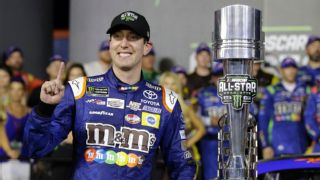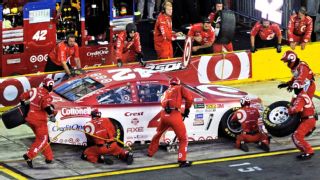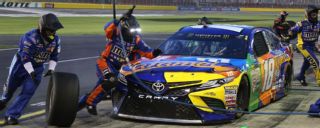|
CONCORD, N.C. -- On the 25th anniversary of an incredible evening of racing dubbed "One Hot Night," NASCAR tried to do something to rekindle the dramatics for its all-star event. It didn't get it. The 2017 version of the Monster Energy All-Star Race will go down in history as "One Hot Blight." Look, give NASCAR and Charlotte Motor Speedway credit for trying. In hopes of thrilling the racing wonks and the diehard race fans, they decided to have a race in which drivers could use one set of softer tires along with three sets of primary, harder tires. The goal was to have teams choosing to use that soft set at a variety of times, creating more passing and dramatics. Instead, NASCAR got a 70-lap, all-star dull-fest that had no lead changes on the track except in the first couple of laps at the start of the third 20-lap stage that was more about who had the freshest tires, and a bold move to open the final 10-lap, 10-driver shootout. In a race in which the talk was tires, tires, tires, it came down to pit stops -- Kyle Busch got off pit road second prior to the final segment ahead of the previously dominant Kyle Larson, restarted third because the rules left Brad Keselowski without tires, and performed a stout move to the bottom on Keselowski to snatch the lead and easily blew the doors off everyone to win by 1.274 seconds over Larson. It was a thrilling night for Busch, who had never won a NASCAR Cup event at the 1.5-mile oval and earned his team $1 million. It also showed that Joe Gibbs Racing, which has not won a Cup points race this year, still has strength and possibly has closed on the competition. "Certainly, it's just a true testament to how hard we all work," Busch said. "I mean everybody in this sport does, but man, I've just been trying for here for so long and the right circumstances came our way."  Charlotte is a track where circumstances need to go a driver's way -- it's a place where the aero push is king, and the leader in clean air has a big advantage. Larson was on the pole and led the first 40 laps. He went with the soft tires for the third segment, won by Jimmie Johnson (who already had used his soft tires in a segment earlier) but a bad pit stop because of a jack issue had him restarting fourth for the final 10-lap stage. Larson and Busch knew after the first lap of the final stage that without another caution, Busch would win. By that time, everyone knew the soft-tire deal had not met expectations. After three drivers used the soft tires at the start of the race and didn't do much, no one wanted to use them for the 10-driver, 10-lap final stage because the rules stated that anyone with those tires would have had to start at the rear of the field. Johnson went from fourth to second in a 20-lap stage with the soft tires. "I have an opinion, but I don't have the answer," Johnson said. "I know you look at qualifying, you look at the cars on the track, we want parity. ... We all run the same speed, no wonder [we] can't pass." Busch said NASCAR and Goodyear did the best they could with the tire choice, considering they didn't have a tire test under similar track conditions to know whether the soft tires would run as predicted -- about 0.3 to 0.5 seconds faster at the start of a run than the primary tires. Those soft tires were about half that at best. "There was a fair amount speed difference between the sets in practice, but everybody's car wasn't dialed in it and the track didn't widen out," Busch's crew chief Adam Stevens said. "As it cooled off, it seemed like the discrepancy just got smaller and smaller and the groove didn't open up very much. "The guys that tried to move up to the middle or the top, there just wasn't the grip up there as there was on the bottom. ... It came down to track position at that point." Ugh. Track position. The words people hate when talking about the 1.5-mile tracks. Especially in an all-star race. The 1992 version featured Dale Earnhardt Sr. crashing on the final lap, and then Davey Allison crashing across the finish line while winning -- and spending a couple of days in the hospital before returning to race the following week. The track made a huge marketing push on the anniversary of that classic. That's what promoters do. And when doing so, they run the risk of not living up to the hype. Even a somewhat fake tire test Thursday with Michael Waltrip driving a racing-school car that produced (surprise!) great reviews proved to be a sorry predictor for what would unravel Saturday night.  This race was meager when it came to fireworks. It had some cool Harley tricks prerace thanks to new sponsor Monster Energy. It had some MMA fights in the midway earlier in the day. But the action on the track needed more than just one set of soft tires issued to each of the 20 participants. It also needed less confusing rules -- it seemed downright silly that Keselowski couldn't re-use the set of option tires he put on and then had to take off because of a loose wheel. That ruined his chances. If NASCAR wants to do this again, it needs to have a tire test (or how about just a practice?) with several cars in hopefully similar conditions. The testing for this race was done in a lab. "I don't think Goodyear hit the tire very well," Keselowski said. "They missed pretty big. The [option] tire was supposed to be much faster." The tires were supposed to faster. The drama was supposed to be greater. "This race was kind of born off of exciting events that were in the race and bold moves and things like that, and we did one of those [on the restart] to win the race," Busch said. "To take home a million bucks, that's not a bad payday." It wasn't a great payday for the sport. Hopefully, the next experiment will bring the heat.
|

